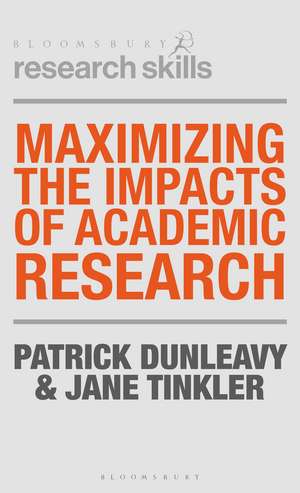Maximizing the Impacts of Academic Research
Autor Patrick Dunleavy, Jane Tinkleren Limba Engleză Hardback – 9 oct 2020
| Toate formatele și edițiile | Preț | Express |
|---|---|---|
| Paperback (1) | 233.81 lei 43-57 zile | |
| Bloomsbury Publishing – 9 oct 2020 | 233.81 lei 43-57 zile | |
| Hardback (1) | 659.10 lei 43-57 zile | |
| Bloomsbury Publishing – 9 oct 2020 | 659.10 lei 43-57 zile |
Preț: 659.10 lei
Preț vechi: 766.38 lei
-14% Nou
Puncte Express: 989
Preț estimativ în valută:
126.12€ • 132.03$ • 104.35£
126.12€ • 132.03$ • 104.35£
Carte tipărită la comandă
Livrare economică 07-21 aprilie
Preluare comenzi: 021 569.72.76
Specificații
ISBN-13: 9781352010992
ISBN-10: 1352010992
Pagini: 409
Dimensiuni: 148 x 210 mm
Greutate: 0.64 kg
Ediția:1st ed. 2021
Editura: Bloomsbury Publishing
Colecția Bloomsbury Academic
Locul publicării:London, United Kingdom
ISBN-10: 1352010992
Pagini: 409
Dimensiuni: 148 x 210 mm
Greutate: 0.64 kg
Ediția:1st ed. 2021
Editura: Bloomsbury Publishing
Colecția Bloomsbury Academic
Locul publicării:London, United Kingdom
Caracteristici
Illustrates impact issues with information drawn from a wide range of disciplines across the STEM sciences, social sciences and humanities
Notă biografică
Patrick Dunleavy is Professor of Political Science at the London School of Economics, and a Fellow of the Academy of Social Sciences. In addition to his disciplinary work, he is well known for his successful guide, Authoring a PhD (Red Globe Press, 2003) and for the LSE Writing for Research blog. His Twitter feed @Write4Research has 68,000 followers from many countries and disciplines. His widely cited 2014 research study of The Impact of the Social Sciences (co-authored with Simon Bastow and Jane Tinkler) provided part of the foundation for this book.Jane Tinkler is Senior Prize Manager at the Nine Dots Prize for innovation in the social sciences. She is also studying for a PhD in public policy at Stirling University. She previously managed LSE Public Policy Group for many years and co-authored The Impact of the Social Sciences (2014). She has also been a researcher in the UK's Parliamentary Office of Science and Technology, and before London School of Economics worked at UCL and Birkbeck College, London.
Cuprins
PART 1: ACADEMIC IMPACTS Chapter 1: How citations work 1.1 The role citations play 1.2 Citation rates across disciplines 1.3 Time lags and citation profiles 1.4 What shapes researchers' overall citation profiles across their careers? 1.5 Handling self-citation Chapter 2: Tracking and understanding your citations 2.1 The 'legacy' citation tracking systems 2.2 Google Scholar's tracking systems 2.3 Web-based citation plus full text 2.4 Altmetrics 2.5 Digital metrics and academic citing behaviours Chapter 3: Planning journal articles 3.1 Getting papers from research projects 3.2 Working with co-authors and research teams 3.3 Deciding where to submit an article 3.4 Understanding the peer review process 3.5 Maintaining a flow of research and papers Chapter 4: Crafting better journal articles 4.1 Choosing an article structure suitable for each discipline 4.2 Writing better -avoiding 'academese' 4.3 Helping other researchers to cite you 4.4 Writing informative titles and abstracts for journal articles Chapter 5: Producing books and chapters 5.1 Books as academic outputs and their citation rates 5.2 Getting your book known 5.3 Edited books 5.4 Chapters in books PART 2: ACADEMIC AND EXTERNAL IMPACTS Chapter 6: Applied work, 'grey' literature and choosing across projects 6.1 Applied work 6.2 'Grey' literature and other publications 6.3 A choice canvass for research and publications options Chapter 7: Digital era scholarship- bigger, better, shorter, faster, free 7.1 Bigger data 7.2 Bigger search 7.3 Better communicated 7.4 Shorter publication forms 7.5 Faster research 7.6 Free access and open access to knowledge Chapter 8: Improving impacts at department and university level 8.1 Committing to knowledge exchange 8.2 Choosing a blogging/digital strategy 8.3 Integrating department and university impact efforts 8.4 University leadership and information flows PART 3: EXTERNAL IMPACTS Chapter 9: Impacts, intermediaries and academic purpose 9.1 What an external impact is (and is not) 9.2 Academia and modern professions 9.3 The impacts interface Chapter 10: Working with other organizations. 10.1 Which academics can link to outside bodies. 10.2 The variety of university links to businesses and other organizations 10.3 How working with outside organizations can benefit research 10.4 The costs and possible risks of working externally Chapter 11: Public engagement and impacts 11.1 Intuitive explanations, research narrative and 'maths dread' 11.2 Who can do public engagement? 11.3 The benefits of getting involved 11.4 Mitigating costs and potential risks Afterword: How the impacts agenda boosts academic progress and democratizes knowledge References.
